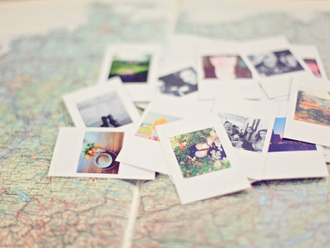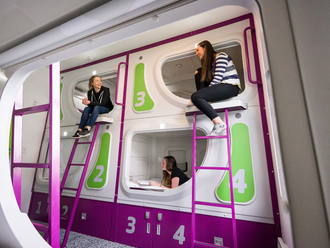
The boat ride on the Mae Klong River in central Thailand was billed as a firefly cruise, but there was no sign of the blinking bugs a half-hour into our nighttime ride.
We were on a narrow, wooden craft in Samut Songkhram, a small province about an hour southwest of Bangkok with a dozen other tourists in pairs on wooden benches. The engine roared as we ploughed through the glossy, black water. The only lights came from the balconied hotels and elevated pagodas on the shore, and from a temple with a startlingly large and hunched black Buddha, in a golden robe with glinting white eyes.
Then, as we rounded a bend and the skipper cut the engine, we drifted toward a twinkling stand of trees, the spindly limbs seemingly strung with strands of white lights. The fireflies weren’t floating around, but were parked on the branches, flickering in unison. For the next 20 minutes, the boatman steered us from bank to bank, drifting past the silent light shows, the stars so bright it was hard to distinguish their twinkle from the luminescence of the insects.
Thailand may be famous for its tropical isles and aquamarine seas, but select rivers and canals in the country’s core offer opportunities for some astonishing adventures as well.
Several major rivers like the Chao Phraya and the Mae Klong course south into the Gulf of Thailand, with dozens of tributaries and canals connecting along the way.
Perhaps because Thailand’s rivers are not as legendary as, say, the Nile in Egypt, where a significant sector of travel is built around tourist ships, there are only a few companies booking cruises with overnight cabins. Mostly the options are hourlong or half-day trips, so we put together our own tour.
When my wife, Susan, and I arrived in Bangkok, I must admit that my uninformed image was that of a chaotic city rife with red-light districts. There are indeed some seedy strips and at times overwhelming traffic and crowds. But we found a well-organised, vast metropolis, with a calming Buddhist vibe. Snaking through this land of ornate temples with golden Buddhas, soaring condo towers and endless street markets, gleaming malls and mouldy tenements, is one of Thailand’s most important waterways.
Although people have lived along the Chao Phraya and its tributaries for centuries, the river powered Bangkok’s evolution from a small settlement in the 1400s, to the nation’s capital in 1782 and to one of Southeast Asia’s dominant economic centres today.
Triple-hulled barges carrying everything from corn for breakfast cereal and cement for construction are a constant presence, led by straining tugboats. But with Thailand’s international tourism continuing to surge — rising nearly 60 per cent in the past six years to 35.4 million visitors in 2017, more than a quarter from China — the barges are far outnumbered by more than 300 boats catering to tourists.
Ploughing through the wide, brownish-gray river from morning to night in central Bangkok are duck-billed ferries, jam-packed water buses, private tour boats and dinner cruise yachts. Slicing through it all are Thailand’s most ubiquitous and distinctive crafts — long-tail boats, like big canoes powered by diesel truck engines with protruding drive shafts tipped with propellers.
We hired one at the pier of the Millennium Hilton, where our room on the 12th floor overlooked the river, and launched into a riotous ride, rising up in 1.2 metre waves and slamming down. The motor screamed like a supersonic jet. The propeller blasted out a fan of white froth.
The boats dock at the city’s most famous temples like Wat Pho, where we entered shoeless into a massive pavilion containing a 46-metre long reclining Buddha and a steady flow of shoulder-to-shoulder gawkers. On the passage along the golden figure’s backside, Thais filed by plinking coins into a row of metal bowls, creating a musical drizzle.
When Tom Praisan returned to Bangkok a decade ago from Los Angeles, he wasn’t satisfied with the hurried and hectic long-tail rides. So he started Pandan Tour, offering full-day and three-hour canal cruises in Thonburi west of the river.
Many of the canals, or khlongs, “were made since the ancient Khmer Empire and we just took them over and built on the system, and it was the superhighway of the nation,” he said. “We build our houses on stilts to protect from the flood. We fish from the water. We use the water to grow rice. That’s just our way of life, to be close to the water.”
We started on the calm and narrow Khlong Dan, the boat’s Toyota car engine emitting little noise or fumes. The banks were thick with banana and mango trees and towering coconut palms. We passed shack after wooden shack perched on the dark water. Their front porches were furnished with pedestaled shrines like dollhouses to keep ancestral spirits content, washing machines and gray cooking pots hung on faded brown boards, and families looking up from supper to smile and wave. Around a bend was a rare two-storey house with two Mercedeses parked in a garage. A large monitor lizard flitting its tongue swam near the bank.
We stopped at Wat Pak Nam, where Buddhist nuns chanted in a hall and we marvelled at a green crystal pagoda several stories high. At the dock, a man and a boy tossed coloured corn puffs into a mass of catfish so thick they were rolling on the surface. It’s taboo in Buddhism to kill, so the fish are safe at temples. “They tell their friends and family to come over,” Praisan said.
On one of our nights in Bangkok, we caught a water bus on the river for 20 baht (Dh3.4) each to see where it took us. The floodlit hotels with sky bars and the sprawling Disneyesque Grand Palace gave way to darkness on the banks as we headed north. We didn’t realise that it was the day’s final run. The pier we were stranded on had an outdoor nail salon, street carts grilling squid and bagging rice and meat slices, and a barnlike building at the end. Inside, locals were shooting pool on a massive table.
On another night, instead of choosing among the dinner cruises offering buffets and dancing, we went with Manohra Cruises’ restored rice barge with waiters serving three courses to two dozen candlelit diners. The food — especially the tom yum soup with shrimp and the mango sticky rice — did not disappoint, though the breeze cooled the entrees.
There are several popular floating markets within a two-hour drive north and south of Bangkok. Decades ago they were essentially supermarkets for locals. Now they are carnivals for tourists, the show on the water supported by hundreds of vendors on planked docks and connecting streets.
After our firefly cruise from the Amphawa Floating Market in Samut Songkhram, we shuffled through the throngs of international tourists past stalls loaded with T-shirts, coconuts, dried fish, Thai boxing shorts, fried quail eggs. We perched on concrete steps leading to three boats on the canal, where a woman grilled large prawns on a fire in a metal box in a boat and a man in the prow mixed papaya salad in a wooden bowl with a pestle. As we feasted on those, Thai songs floated from a karaoke setup across the water. Long-tails growled slowly along, stuffed with tourists in orange life jackets.
We stayed a mile upstream at a seven-room guesthouse tucked in the trees along a muddy bank. Simon Sriganta, a 28-year-old entrepreneur, built the River Jam with an open-air dining room and Singer sewing machine stands for tables. He opted for seclusion over a site on the broad Mae Klong.
“It feels so relaxing when we sleep,” he said. “This size is OK, you can see everything, you can look to the coconut tree.”
He let us rent his car one day for the two-hour drive northwest to a section of the Mae Klong called River Kwai. Nearly 7,000 Allied prisoners of war who died during the construction of the Thailand-Burma railway in the Second World War are buried across the street from the town’s Death Railway Museum. As you walk the cemetery’s rows of bronze plaques you can almost hear the Colonel Bogey March whistled in the 1957 movie Bridge on the River Kwai. In fact, the tune pierces through the museum on a video with interviews of English veterans who survived tropical diseases, meagre rations and the brutality of their Japanese captors. The museum has an impressive narrative of the railway covering the walls with facts like how POWs secreted details of their ordeal in coffins.
Walking over the steel bridge, the forested hills in the distance, I imagined the prisoners on the structure as Allied bombers attacked in 1945, severing the span and clouding the water with blood.
The bridge was rebuilt after the war, and now you can watch a regional train pass over from restaurants on floating docks, and notice that the engine on the tethered long-tail is Isuzu, the Japanese brand.
Another train worth seeing is back in Samut Songkhram at the Maeklong Railway Market. Eight times a day, tourists with cameras and smartphones pack a railroad crossing that has a train depot on one side of the road and what looks like a permanent market on the other. Awnings and big umbrellas stretch 100 yards along the line, concealing the track. Underneath, visitors and merchants crowd tables loaded with tubs of silver fish, slabs of raw meat and bushels of spices.
Every couple of hours, the awnings are retracted, the metal tables are rolled back and a giant locomotive crawls through, parting the souq like Moses at the Red Sea. The train cars passed by just inches from our bodies squeezed against the stalls. Then the awnings were tilted back down, the tables pushed forward and the crowds filled the rails.
There’s no better way to end the journey than back on the water on what may be the only boat in Amphawa that offers a Thai foot massage. We stepped onto Hatthatara’s boat, sinking into sturdy deck chairs with wide, cushioned seats and footrests. Those were the workbenches of the Thai masseuses who, equipped with bottles of coconut oil and years of experience, kneaded, poked, rapped and wrapped our feet and calves. After that, walking through the throngs never felt better.












